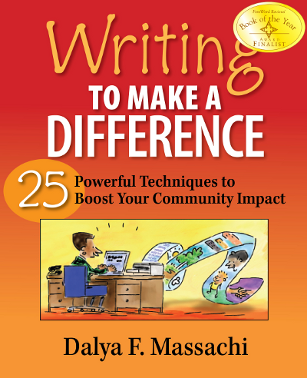[Dalya’s Note: This is an excerpt from my award-winning book Writing to Make a Difference: 25 Powerful Techniques to Boost Your Community Impact.]
 Do you know the big question on the mind of every reader of your organization’s material? It’s this: “What’s in it for me?”
Do you know the big question on the mind of every reader of your organization’s material? It’s this: “What’s in it for me?”
As far as your readers are concerned, it’s all about the benefits you can offer them. You want to emphasize how your organization’s product or service improves the lives of your constituents and their communities.
We tend to focus on all of the wonderful features of the services and products we offer. But if you try to see things from your readers’ perspective, you will notice that they are most interested in buying or supporting benefits that address their specific needs and values.
For this reason, writing about benefits that matter to your readers is absolutely crucial in any kind of marketing or fundraising piece. I am talking about everything from a personal letter requesting financial support, to a general flyer about a service you offer, to a special report about your industry, to a website article.
Don’t just concentrate on what specific things your organization does or makes, or how. Those are the various features of your work. While those are interesting and necessary to discuss, I suggest you emphasize what difference your organization makes—how your services benefit the users, your supporters, and/or the community at-large.
![]() Ask Yourself: How will your service or product improve the lives of your readers and their community, in the short and the long term?
Ask Yourself: How will your service or product improve the lives of your readers and their community, in the short and the long term?
Did you notice how I said both your readers and their community? That is because we work in the public interest sector and not the conventional business world. Our stakeholders want to find ways to benefit both themselves and the world around them. So we might want to edit their big question to now read: “What’s in it for me and us?”
Simply put, your job is to refine your text (your “copy”) so that it makes your readers feel good about the benefits you are offering. You want them to feel so good that they are willing to take a chance on you with their time, money, energy, or other resources.
Your writing has to persuade them that your product or service will help them achieve their goals, benefiting them and their community.
This “feel-good” imperative reminds me of the old toothpaste commercials that implied that you would find love and romance if only you brushed with their minty fresh taste. Or of today’s cell phone ads suggesting that their products will win you lots of new friends and dates. While this is a blatant use of persuasive power, we can use that power in the public interest too.
You can, over time, compile especially effective phrases, paragraphs, and statements to recycle in your materials. But, of course, you will have to tweak everything to make sure it uses language that speaks most persuasively to your specific intended audience.


 [Dalya’s Note: This guest post by Anne Michelsen was originally published on April 8, 2013 on her website,
[Dalya’s Note: This guest post by Anne Michelsen was originally published on April 8, 2013 on her website, 



